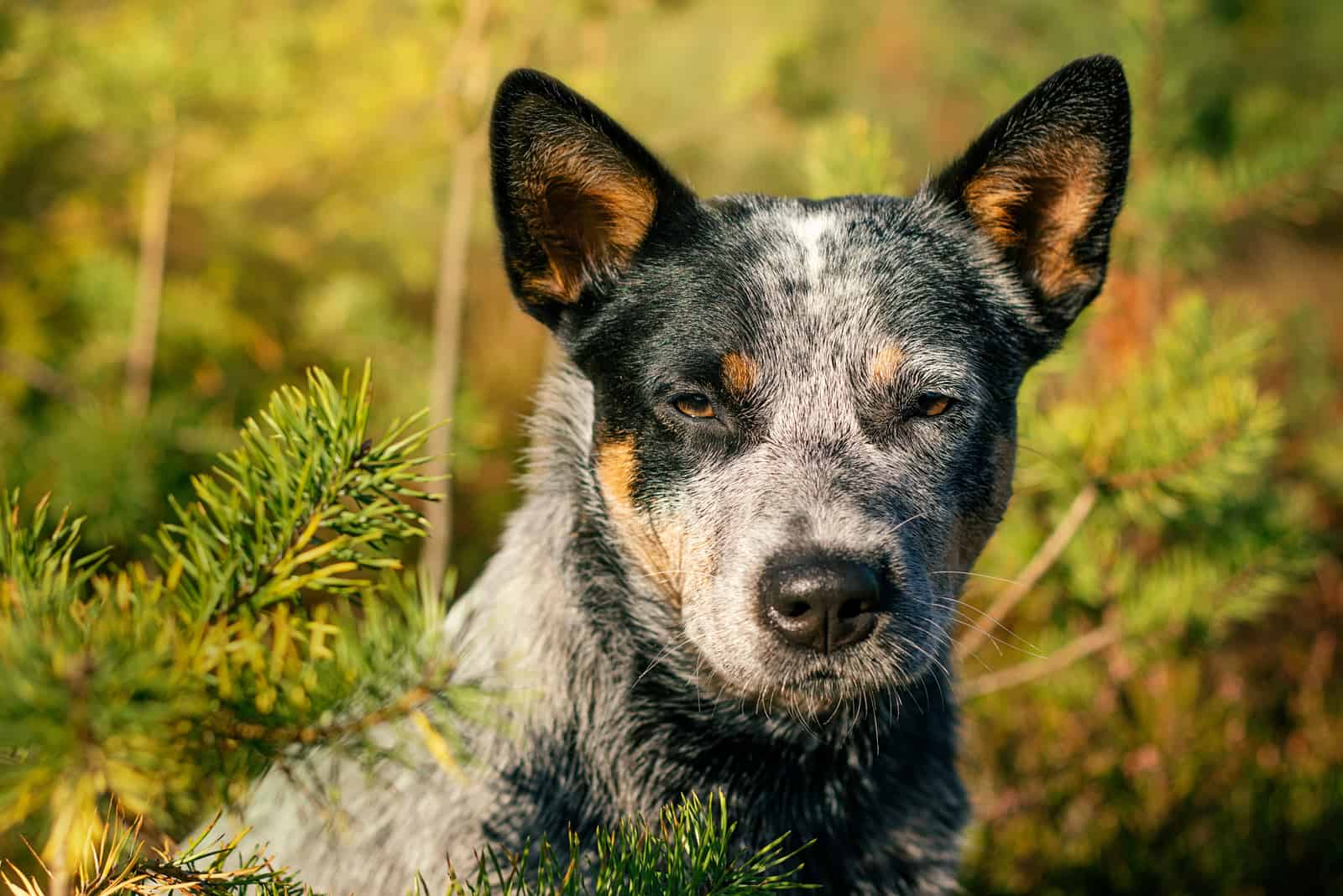The Blue Heeler dog breed (also known as the Australian Cattle Dog or the Queensland Heeler) originated in the mid-19th century in Australia, when British settlers brought their Border Collies to Australia.
At the time, local Australian farmers and ranchers were in dire need of a good herding dog to assist them with livestock since the Collies that were brought from Britain simply lacked the stamina and endurance necessary to do the job.
A local Australian breeder seized this opportunity and crossbred the imported Collies with the native Australian Dingoes – which first resulted in a regional dog breed.
This regional breed was then further crossed with black-and-tan Kelpies and Dalmatians – finally giving rise to the Australian Cattle Dog breed as we now know it.
The blue merle coat color inherited from the Collies coupled with the inherent wild nature of the native Dingoes (which made them proficient at herding cattle) earned them the nickname, Blue Heeler.
So, whether you already have a Blue Heeler puppy or you’re thinking about buying one, it’s important to know just how big this unique dog breed can get.
That’s why a simple tool like the Blue Heeler growth chart can be useful for keeping track of your puppy’s development.
Stick around to find out everything you need to know in order to be prepared for your Blue Heeler puppy’s inevitable growth spurt.
Blue Heeler Growth Chart
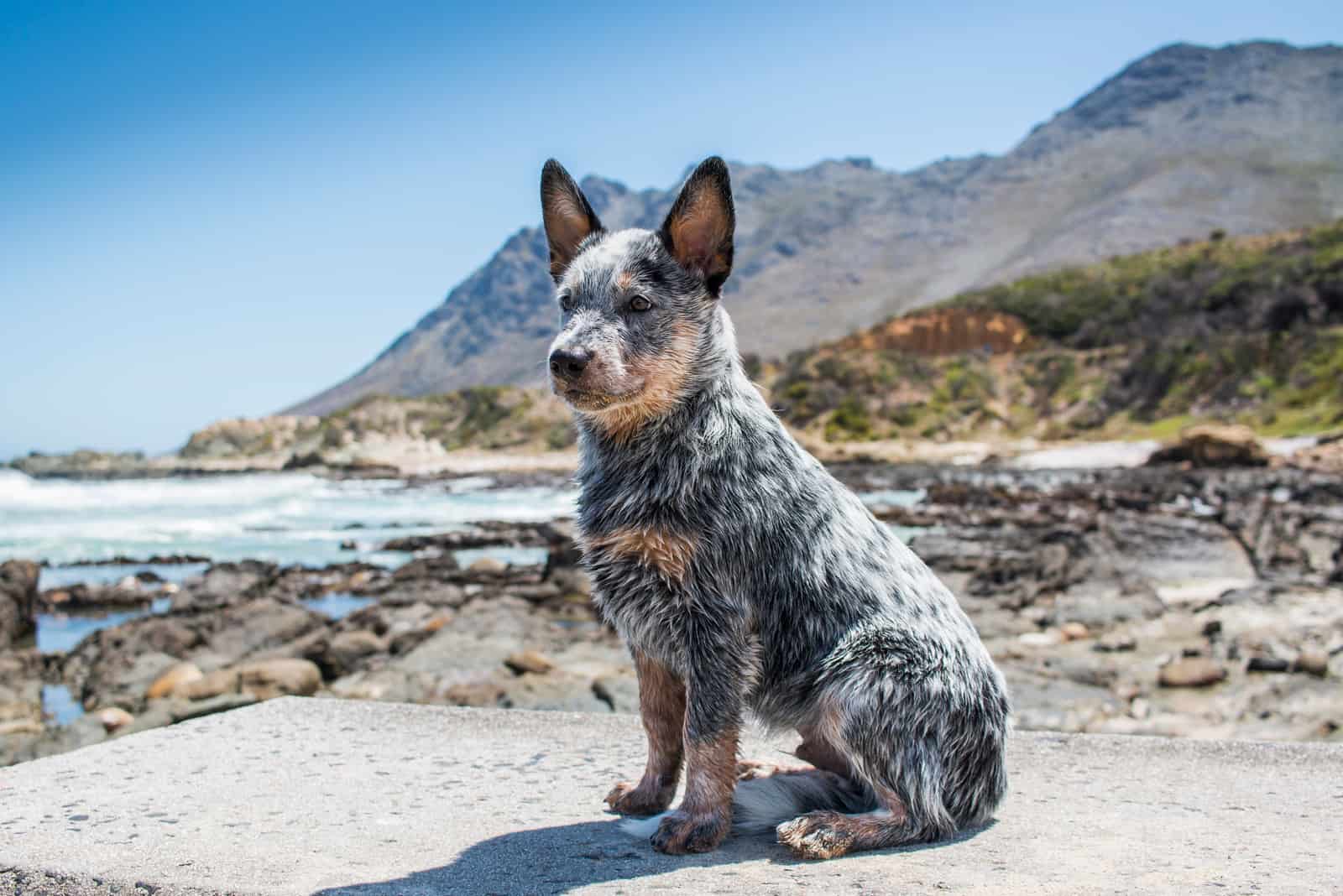
So, how big do Blue Heelers get?
Here’s a puppy weight chart for the average Blue Heeler puppy up until twenty-four months of age.
| Age | Weight Range in lbs. | Weight Range in kg. |
|---|---|---|
| 3 Months | 12 lbs – 15 lbs | 5.5 – 6.8 kg |
| 4 Months | 15 lbs – 18 lbs | 6.8 – 8.1 kg |
| 5 Months | 20 lbs – 24 lbs | 9 – 10.8 kg |
| 6 Months | 23 lbs – 26 lbs | 10.5 – 11.8 kg |
| 7 Months | 25 lbs – 29 lbs | 11.3 – 13.1 kg |
| 8 Months | 26 lbs – 30 lbs | 11.8 – 13.6 kg |
| 9 Months | 27 lbs – 31 lbs | 12.2 – 14 kg |
| 10 Months | 28 lbs – 33 lbs | 12.7 – 15 kg |
| 11 Months | 29 lbs – 34 lbs | 13.1 – 15.4 kg |
| 12 Months | 30 lbs – 35 lbs | 13.6 – 15.9 kg |
| 16 Months | 31 lbs – 45 lbs | 14 – 20.5 kg |
| 24 Months | 45 lbs – 50 lbs | 20.5 – 22.6 kg |
What If my Heeler Puppy Differs From The Norm?
Keep in mind that because these figures are estimates for the average Blue Heeler puppy, your pup might be a bit on either end of the spectrum in terms of the average puppy weight range – but that’s completely normal.
Just like every other dog breed, each individual Australian Cattle Dog puppy develops at its own pace.
However, it’s worth mentioning that some adult Blue Heelers can become overweight if they are overfed and don’t get an adequate amount of exercise.
Another reason for a dog’s extreme weight gain or weight loss might be an undiagnosed medical condition.
On the other hand, some Blue Heelers can grow to as much as fifty-five pounds in weight and still be considered healthy dogs without any underlying medical condition.
It’s your responsibility as the dog owner to monitor your puppy’s growth and consult with a veterinarian in order to determine whether or not your puppy is of healthy dog weight.
Blue Heeler Size Chart And Weight Chart

The puppy growth chart of an average Blue Heeler puppy gives an approximation for the size of your puppy.
Keep in mind that these figures are meant to serve as a general guide for what is typically considered to be the normal development of the Blue Heeler dog breed.
It’s meant to serve as a tool for Blue Heeler owners to monitor their puppy’s development in order to make sure that the pup is hitting all of its developmental milestones.
It’s also very useful for planning ahead since you will definitely need to make the necessary arrangements in order to be prepared for your Blue Heeler puppy’s inevitable growth spurt.
Blue Heeler Body Condition Score
Body Condition Score, or BCS, for short, is a technique used to determine the amount of body fat in animals – it is similar to the Body Mass Index (BMI) for humans.
There are two BCS scales – one that ranges from one to five, and the other that ranges from one to nine.
It should be fairly obvious that depending on whether your dog scores closer to either end of the spectrum is how much body fat it has.
If your pup scores a 1/9 or a 1/5 – it’s underweight and needs to put on more weight in order to stay healthy.
On the other hand, if your pup scores a 9/9 or a 5/5 – it’s considered overweight and needs to lose that excess weight in order to function properly and avoid further health issues.
The ideal BCS should be somewhere in the middle of the scale – healthy dogs score 5/9 or 3/5.
If your dog is not within the parameters of the BCS to be considered healthy, there are certain measures you can take in order to help it.
Blue Heeler Developmental Stages
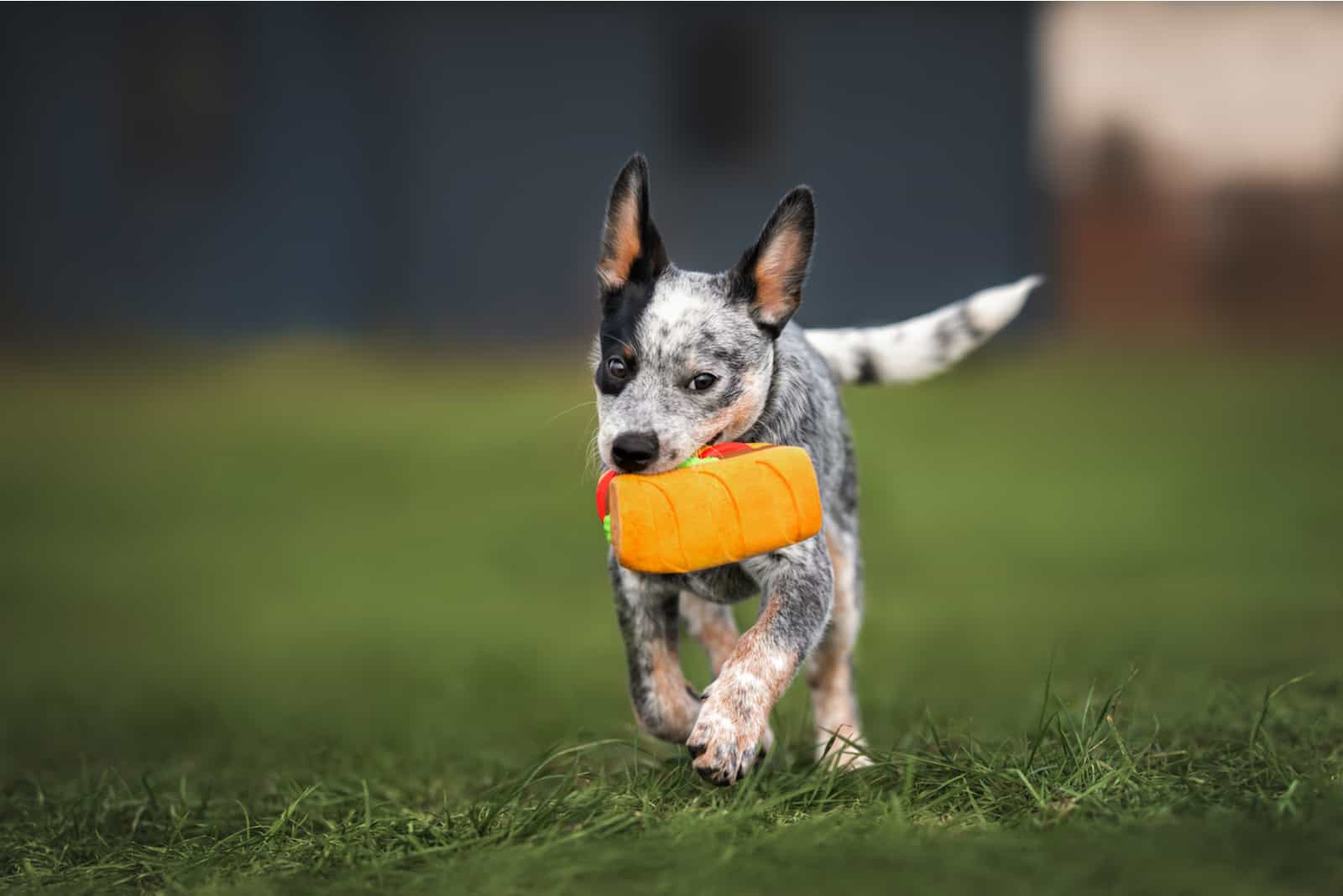
Now, let’s take a quick look at the developmental stages of puppies in general – from birth to adulthood – so that you can better understand what to expect from your Blue Heeler puppy.
Birth To Two Weeks – Neonatal Period
Just like any other dog breed, when they come into this world, Blue Heeler puppies are in their most vulnerable state.
They are unable to feed or clean themselves, regulate their own body temperature, and eliminate waste, so they rely heavily on their mother as their only means of survival.
During this neonatal stage, their ears and eyes are not yet open, and they cannot walk yet, so they spend most of their time sleeping and eating in order to put on a bit of weight before they are able to walk.
Newborn Blue Heeler puppies weigh from seven to eleven pounds on average.
Fun fact about a Blue Heelers’ coat
If you’ve never had the chance to see a newborn Blue Heeler puppy, it might surprise you to know that they’re born with a completely white coat.
In adulthood, their uniquely colored, grayish-speckled coat is what makes them easily distinguishable from other breeds – but Blue Heeler puppies are always born with a white coat that gradually turns blue-gray or red as they grow.
Both of these coat color varieties are characterized by a distinctive speckling pattern.
Two To Four Weeks – Transitional Period
During the transitional period, between the two and four-week mark, the puppies’ eyes start to open and they are able to stand and walk on their own.
Their sense of hearing and smell develops, they start to wag their tail, and their puppy teeth start coming in.
At this time, they will also begin to bark as a means of communication with their littermates and mother.
By the end of the transitional period, when they are four weeks old, they should be able to eliminate waste on their own and be able to better regulate their body temperature.
Four To Twelve Weeks – Socialization Period
During this timeframe, your Blue Heeler puppy should be introduced to other humans and dogs.
By the five-week mark, puppies are well aware of their surroundings, and they will begin to enjoy playing with their littermates and mother – this is the crucial period of a puppy’s development when they learn proper dog socialization cues.
Then comes the fear period, which lasts from eight to ten weeks – this is a completely normal part of puppy development where they are fearful of loud noises and other objects they are not familiar with.
This can be mitigated with the use of positive training methods and encouragement.
After the initial fear period is over, your Blue Heeler puppy will actively start to explore its surroundings with more confidence, and will continue to work on its social skills.
Three To Six Months – Ranking Period
This is the time period when your puppy will hit its first big growth spurt – it will rapidly begin to grow taller and put on weight and muscle.
They become even more independent and confident in themselves, so they will need less attention from their owner.
This is also the timeframe when it’s crucial to begin proper training and establish yourself as the dominant authority since it’s way more difficult to train a puppy after the ranking period.
How much should a Blue Heeler weigh at six months?
If you’re wondering how big your Australian Cattle Dog puppy should be at the six-month mark, the average six-month-old puppy should weigh between twenty-three and twenty-six pounds.
As far as the height of your puppy, the average six-month-old Blue Heeler should stand at a height of around fourteen inches at the withers.
Seven To Nine Months – Sexual Maturity
This is the period of time when your Blue Heeler puppy starts to exhibit the first signs of sexual maturity.
Male Blue Heeler puppies will be able to produce sperm, while their female counterparts will go into heat and experience their first oestrus cycle.
It’s crucial to closely monitor your puppy during this stage in order to prevent them from seeking out mating partners and copulating at such a young age.
At the end of this period, the average Blue Heeler puppy should weigh around thirty pounds.
It’s worth noting that small dogs like Teacup Pomeranians usually stop growing at around nine months old, while medium breeds like Corgis, and large dogs like the North American Mastiff, continue to grow after the sexual maturity stage.
Ten To Twelve Months – Adolescence Period
At this stage of your Blue Heeler puppy’s development, due to the secretion of sexual hormones in its body, you might notice that your pup’s growth rate is slowed down (especially for male Blue Heelers).
This is also the time when you should consider whether or not you want to breed your puppy.
If you decide not to breed your pup, then you should consult with a veterinarian and make arrangements for a spaying/neutering procedure to be performed.
By the end of the adolescence period, your Blue Heeler puppy should weigh around thirty-five pounds, and reach its full height of about seventeen to twenty inches at the withers.
Adulthood
After the first twelve months of your new puppy’s life, it can be considered an adult dog.
Of course, as with all things in life, there can always be deviations from the norm, but we can safely say that the average healthy Blue Heeler puppy can be considered an adult dog at the one-year mark.
At this time, your Blue Heeler should be well-built – robust, compact, and muscular, whether male or female.
Of course, you can expect your Blue Heeler to continue to put on more healthy weight and muscle until it is at least two years old and reaches its final adult size.
This is a pretty common denominator in a lot of medium and large dog breeds such as Poodles, German Shepherds, Australian Shepherds, Golden Retrievers, and many more.
What To Do If Your Blue Heeler Puppy Is Underweight

As a responsible dog owner, you likely want to keep track of your puppy’s developmental progress.
Keep in mind that it’s completely normal for a growing puppy to deviate from the average weight and size chart ranges since every dog develops at its own pace.
However, if you have an adult Blue Heeler that has a low BCS, you should speak to a veterinarian in order to determine the cause of your dog’s low weight.
Your vet will likely want to run some tests in order to determine whether or not there is an underlying medical condition that needs to be addressed.
If your vet finds that there is nothing medically wrong with your pup, all you need to do is create a new feeding schedule and amp up the amount of food you feed your Blue Heeler daily.
You can check out our Blue Heeler feeding chart for more information!
Monitor your dog’s progress over the next few weeks of its new and improved diet and watch your pup slowly start to gain a bit of healthy weight.
What To Do If Your Blue Heeler Puppy Is Overweight
On the other hand, if your Blue Heeler’s BCS is high, then your pup is overweight and you should do the same and take your dog for a checkup with the vet.
If the veterinarian determines that your pup does not have any underlying medical condition that might be the cause of your pup’s weight gain, then it’s your job as the dog owner to help it lose some of that excess weight.
Here are some helpful tips to keep in mind in order to help your puppy lose weight.
You need to increase the amount of daily exercise in order for your dog to burn more calories than it consumes. This can be done by first taking it out for long walks and then gradually increasing the frequency and duration of the walks.
For a limited time period, until your dog’s weight stabilizes, you should stop giving it treats and table scraps.
Work with your veterinarian in order to create a feeding plan for your dog. The amount of food your dog eats on a daily basis and the kind of food you feed it play a big role in your dog’s overall health and weight – a balanced diet should do the trick.
Monitor your dog’s progress over the span of a few weeks and you will see the improvement in its physique.
Will Your Blue Heeler Still Grow After Being Spayed/Neutered?
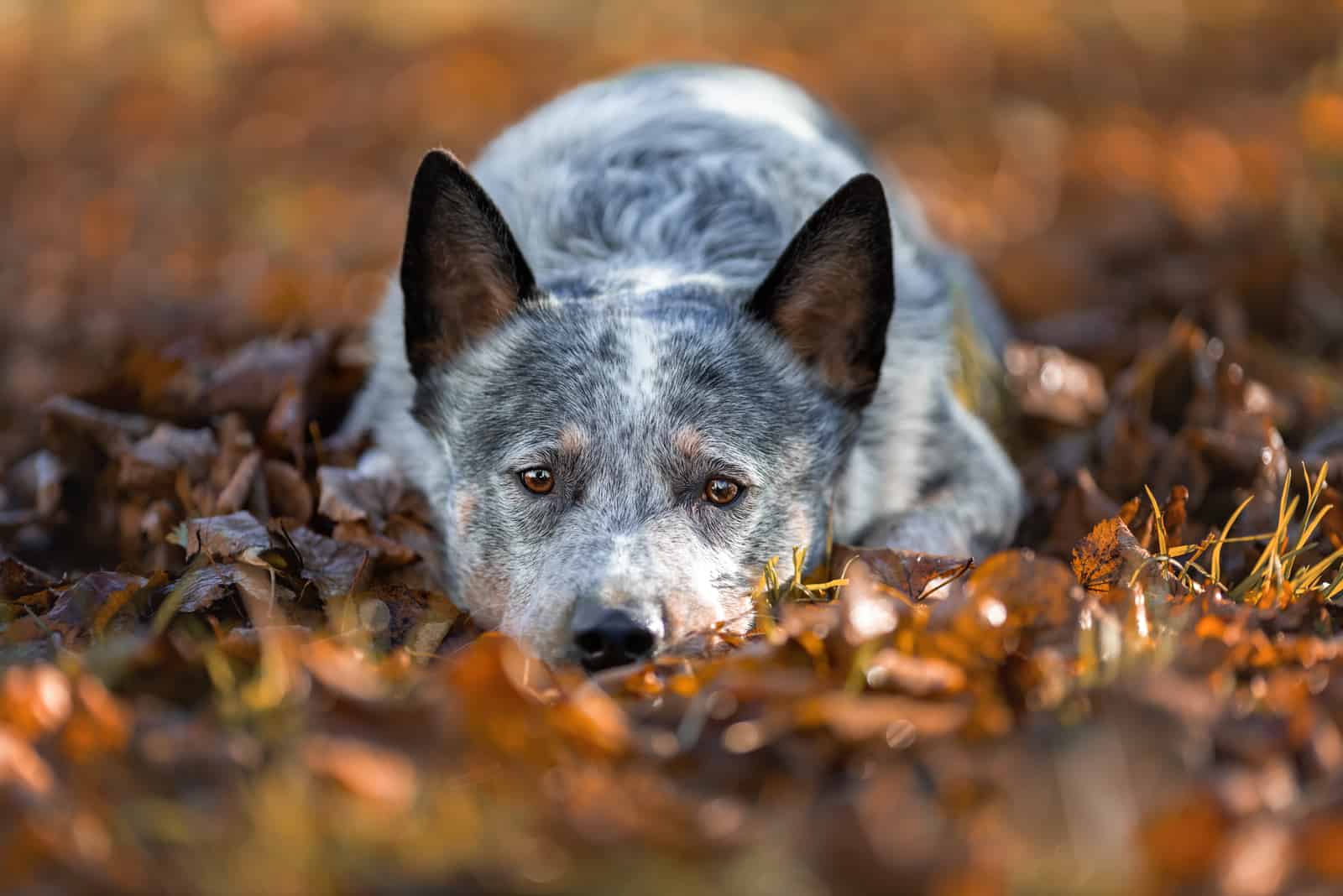
Neutering and spaying are medical terms that refer to the removal of an individual dog’s reproductive organs – neutering is the removal of testicles in male dogs while spaying is the removal of the uterus and ovaries in females.
These medical procedures, although invasive, do not affect the growth of a Blue Heeler if they are performed at the right time.
The ideal timeframe for a spaying/neutering procedure is around ten months of age.
That said, it’s always best to consult with a professional veterinarian before you decide to go through with any medical procedure, and in no circumstance should you opt for someone who is inexperienced.
There are both benefits and risks to fixing a dog, so you should thoroughly research the matter before you decide anything.
Factors That Affect A Blue Heeler’s Growth
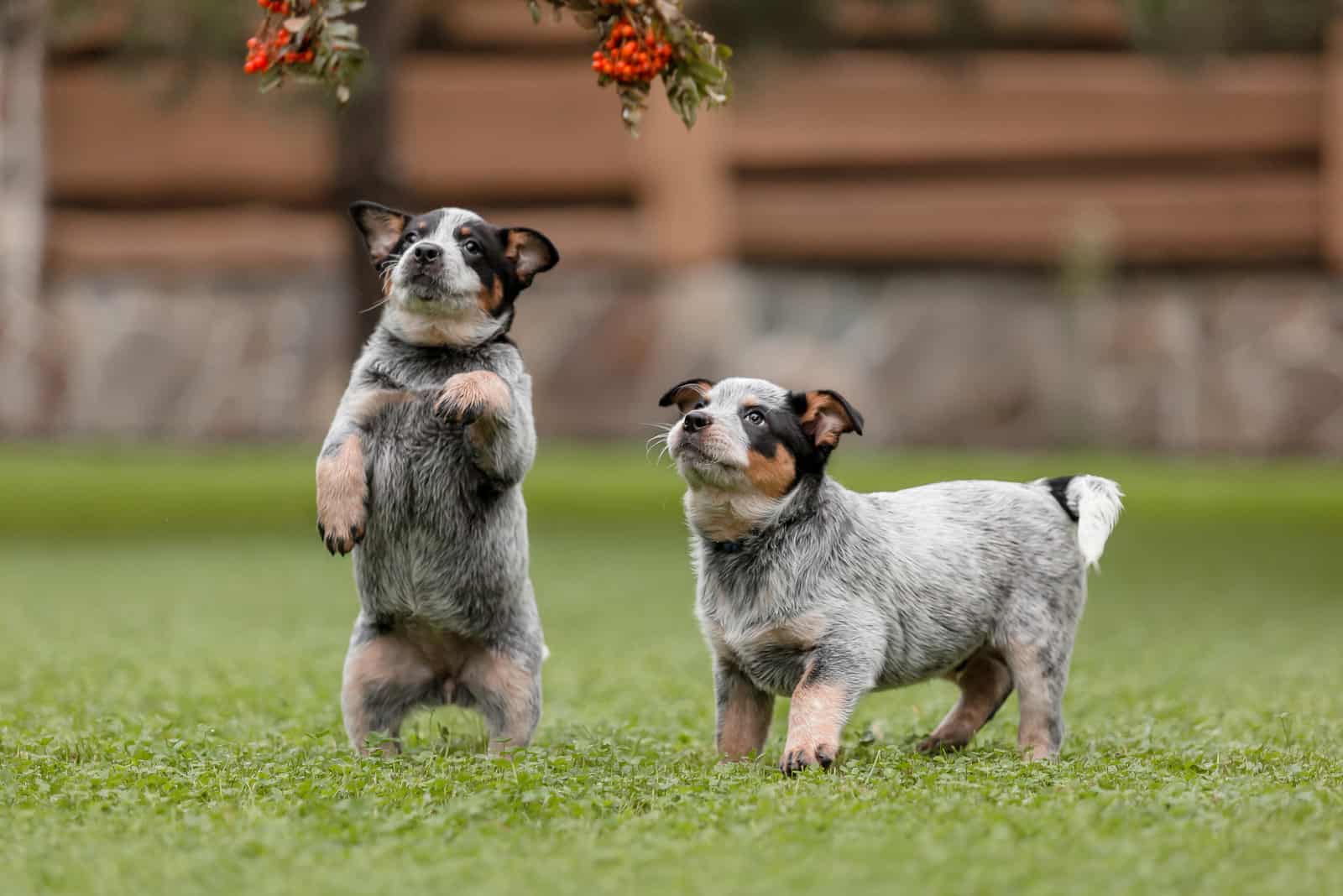
It’s worth noting that there are several different variables that influence a puppy’s growth, and Blue Heelers are no exception to this rule.
The following are the factors that impact a puppy’s growth:
Nutrition
In order to aid your puppy in its development best, it’s crucial to feed it the right dog food.
Adequate nutrition and a balanced diet are key to the proper development of a puppy, especially during the early puppyhood stage.
The food your puppy consumes can either aid or stunt its growth, so it’s important to feed it a high-quality, nutrient-dense food, and potentially augment it with supplements.
If you try to save a few pennies by purchasing low-quality dog food, you’ll certainly end up paying for it down the line when your puppy becomes malnourished and potentially develops a health problem.
Genetics
Okay, we admit that this one is fairly obvious. Just like all other animal species on the planet, dogs are also heavily influenced by their genetic makeup.
Genes that are responsible for growth rates and certain hereditary diseases are biological factors that cannot be controlled by human intervention.
The only thing we humans can do is genetically health test dogs before we breed them in order to determine whether a parent dog is a carrier of a hereditary disease or not.
Keep in mind that although your puppy might deviate from the growth chart standards when it’s still growing, it will most likely fit the standard when fully grown.
Physical Activity & Health
Because they are a highly-active breed that is classified in the herding dog group, Blue Heelers need a lot of physical activity in order to stay healthy and develop properly.
Adequate amounts of daily exercise are crucial for the proper development of muscle tissue and bone density, especially for young puppies.
Another good thing about exercise is that Blue Heelers adore it – they are in their best mood when allowed to participate in any outdoor activity, and they will be delighted to join you wherever you go.
It’s also worth noting that by keeping your dog physically active, you divert its energy away from destructive behavior, such as chewing on your favorite couch.
Common Blue Heeler Health Concerns
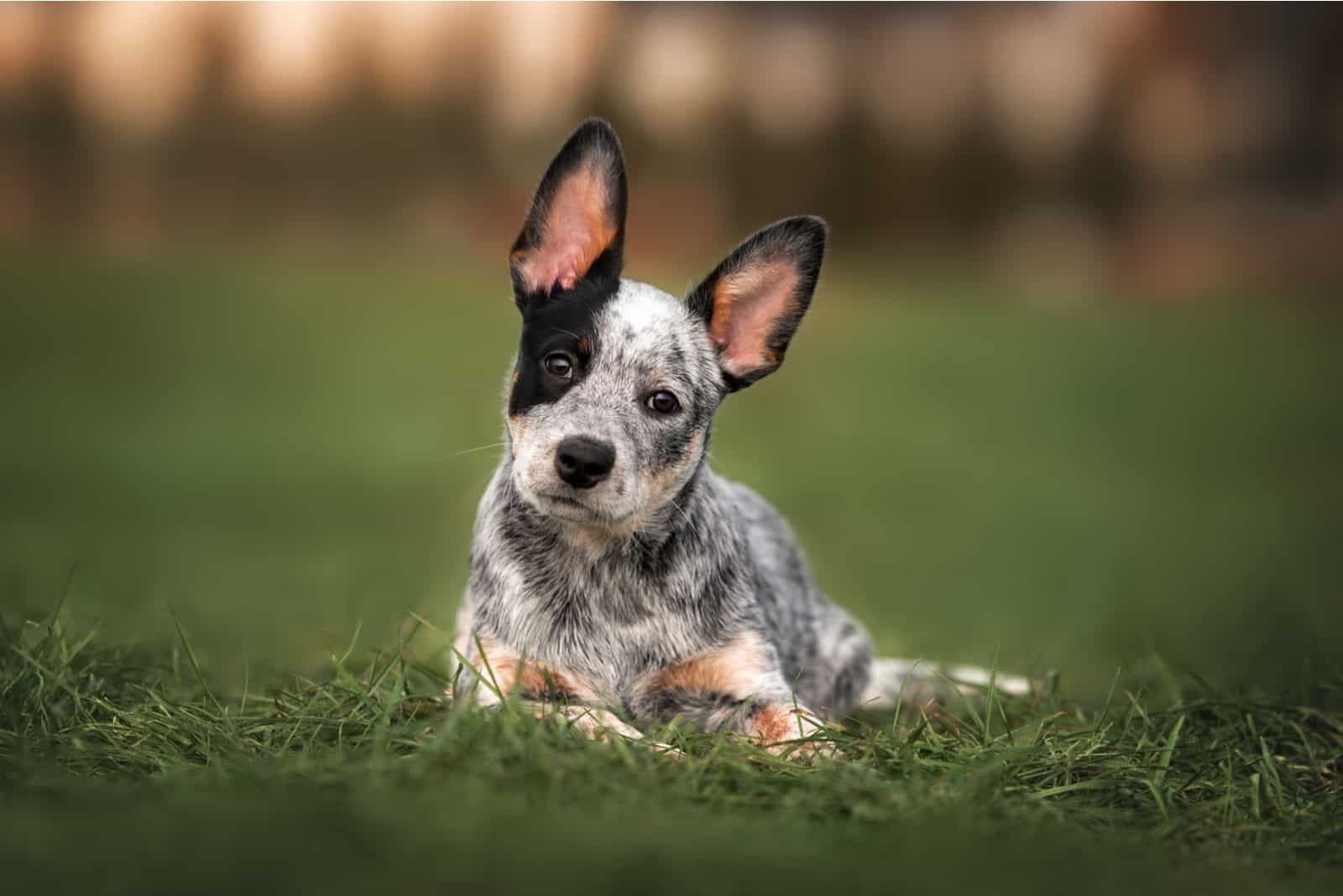
Just like most dog breeds, there are certain breed-specific, genetic health issues that Blue Heelers are prone to.
Your Blue Heeler puppy might or might not have a hereditary health condition depending on whether or not its parents are carriers of a certain genetic illness.
The only way to know for sure is by health testing the breeding dogs before they are bred.
That is why responsible breeders always perform genetic health testing on their breeding dogs in order to be able to breed healthy litters.
Some of the major breed-specific health conditions that appear in Blue Heelers are diseases such as PRA (Progressive Retinal Atrophy), elbow and hip dysplasia, OCD (Osteochondrosis Dissecans), cataracts, PPM (Persistent Pupillary Membrane), and deafness.
Other than these inherent health conditions, it’s important to note that Blue Heelers need to have their teeth brushed regularly as well as their ears cleaned in order to avoid the buildup of earwax.
Life Expectancy Of Blue Heelers
The average lifespan of a Blue Heeler dog is between twelve and fifteen years.
Most frequently, Blue Heelers pass away from natural causes in old age at around thirteen years old.
The reason why they live so long is that they are medium-sized dogs, and long-time experience has shown that small and medium-sized dogs live longer than their larger cousins.
That’s why Dachshunds, with an average fifteen-year lifespan, usually outlive Labradors with an average lifespan of twelve years.
On that note, there actually is a smaller version of the Blue Heeler called the Miniature Blue Heeler – now there’s a dog you don’t see every day.
A Mini Blue Heeler is what you get when you selectively breed a standard Blue Heeler with a considerably smaller breed like the Chihuahua.
Of course, if you keep your Blue Heeler puppy well-fed, healthy, and exercised, and you take it for frequent vet checkups, it will most likely live a long and happy life by your side.
How Long Does It Take For A Blue Heeler To Be Full Grown?
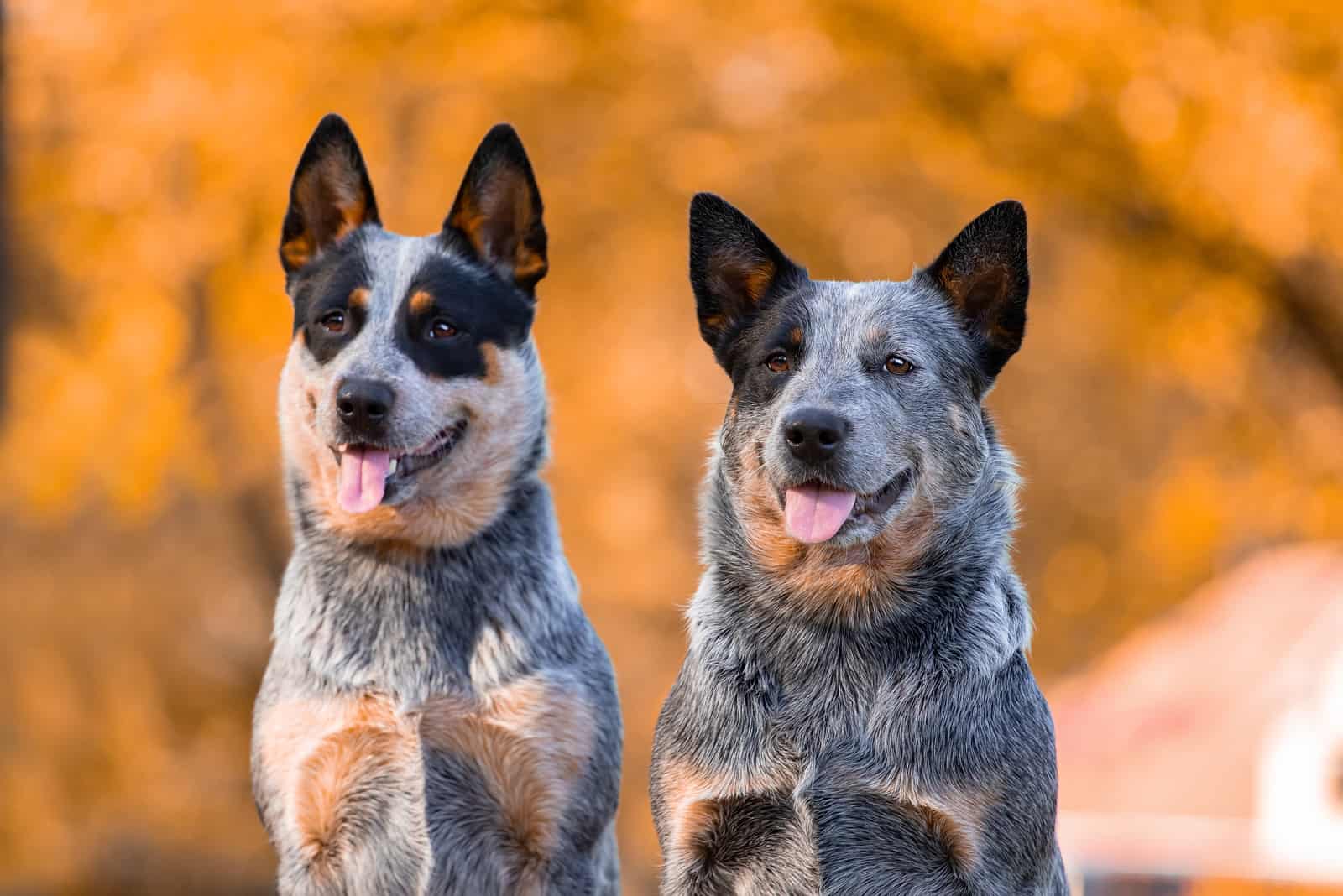
Blue Heelers are considered to be a medium-sized dog breed, and they are typically full grown when they reach twenty-four months of age.
They usually reach their full height between nine and eleven months of age, although their growth plates finish healing at around the one-year mark.
As far as their full adult weight goes, they typically reach it around the two-year mark.
The only reason why they are not considered to be fully grown at the point when they reach their full height is that it takes more time for them to put on the additional weight.
Of course, as with most dog breeds, male Blue Heelers tend to be both heavier and a bit taller than their female counterparts.
The Blue Heeler breed standard established by the AKC (the American Kennel Club) for male dogs of this breed is between thirty-five and fifty pounds of weight, and a height of eighteen to twenty inches at the withers.
The breed standard for female members of the breed is considered to be a healthy weight of between thirty and thirty-five pounds, and a height of between seventeen and eighteen inches at the withers.
In Conclusion
Blue Heelers (or, as most people abbreviate their already short nickname – Heelers) are not the type of dog breed for first-time dog owners.
Their high-energy levels and love for all things outdoors are only compatible with people who live a high-paced and energetic lifestyle.
Blue Heelers are simply not the type of dogs to be content with chilling around on the sofa all day.
However, their intelligence, tenacity, and eagerness to obey make them excellent companion dogs and working dogs for people who can handle them.
By now, you should have a firm grasp as to how big a Blue Heeler puppy can get.
That said, whether you already have one or you’re about to buy one, make sure to use the Blue Heeler growth chart as a useful tool that will help you monitor your puppy’s progress.
Related articles:
• Jack Russell Blue Heeler mix – All about this energetic crossbreed
• Maltipoo growth chart – How large will my puppy get?
• German Shepherd growth chart – How big your GSD puppy will be

